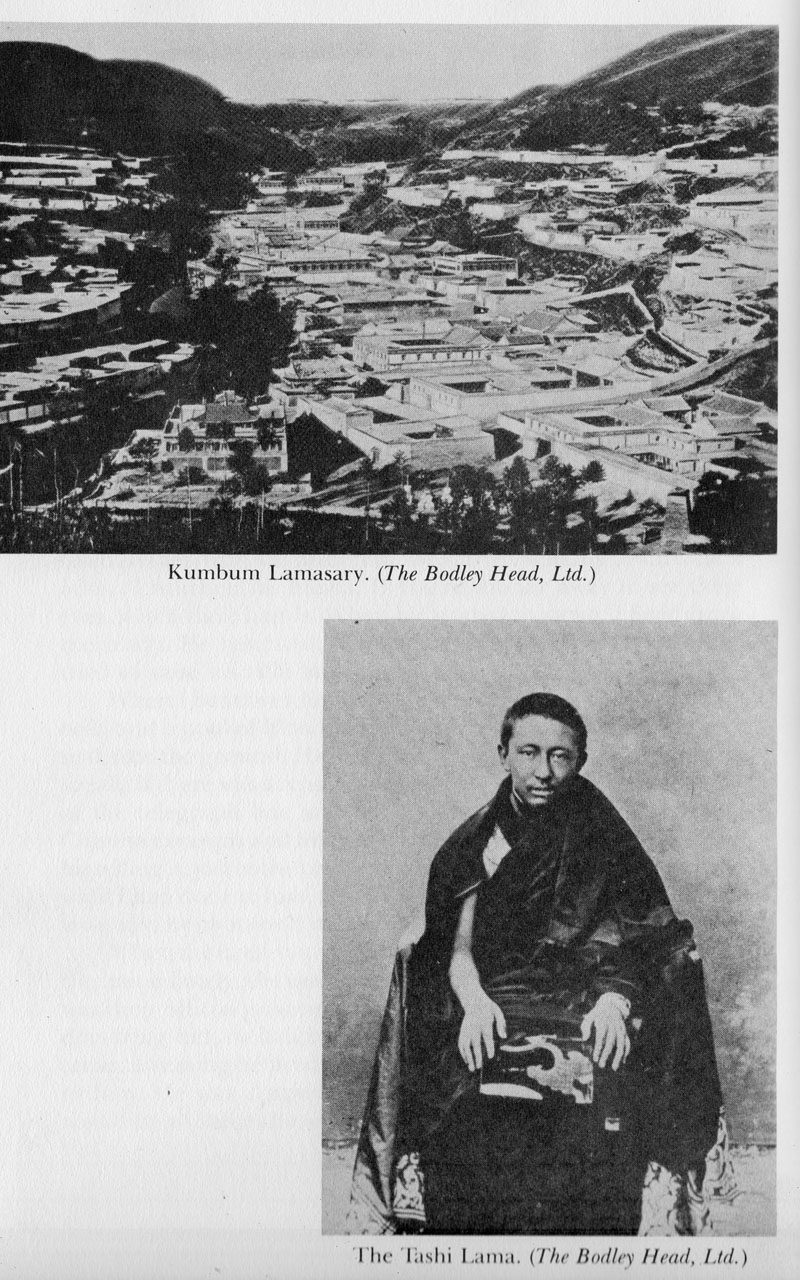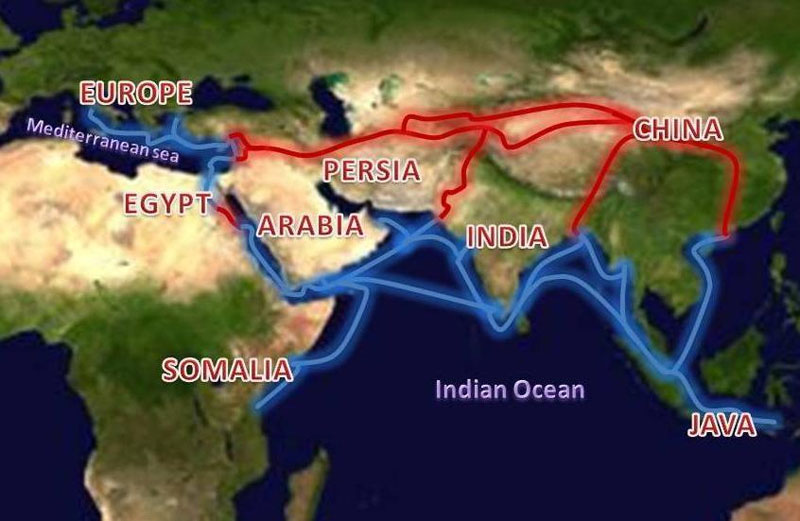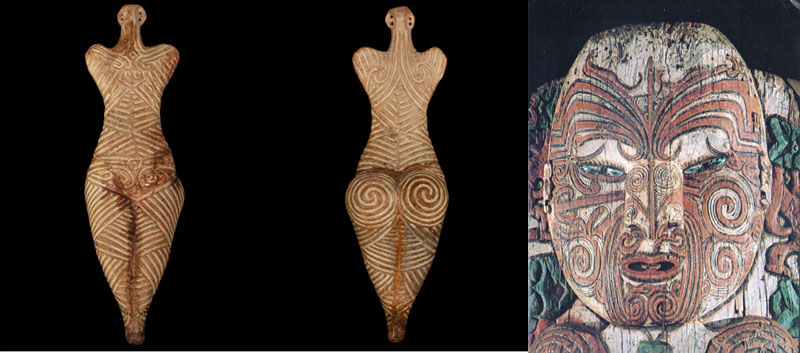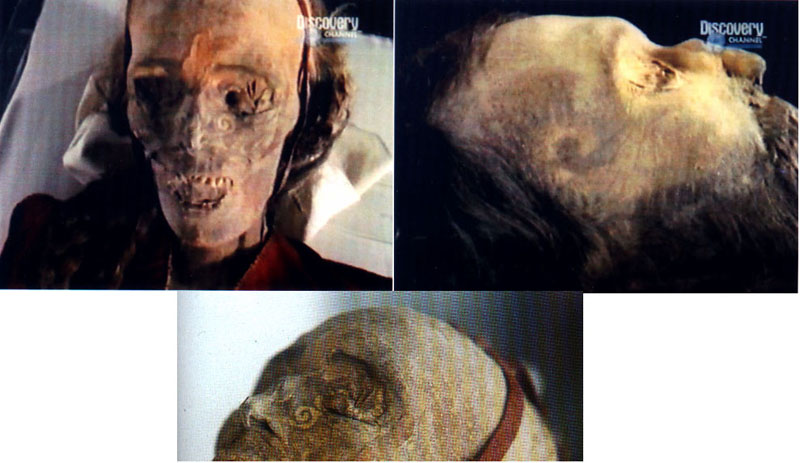
THE CHINESE PYRAMIDS AT XI'AN, SHAANXL
Lying about 7.5-miles southeast of Xi'an City in the rural countryside is a cluster of huge earthen pyramids, the existence of which remained largely unknown to the worldwide research community until only about 20-years ago.
With the recent liberalising of sanctions and the opening up of forbidden zones within China, which were formerly no-go zones to foreigners, increasing amounts of knowledge concerning China's ancient history are becoming accessible for the first time.
With the tools now available through Google Earth satellite imagery, we can visit the various complexes of pyramids within China and measure them with good relative accuracy. We can also check their alignments in relation to the primary points of the compass or measure distances and angles between the different pyramids within each overland complex
The nagging question amongst many researchers is: How old are these pyramids and who built them? We know that various Chinese emperors or others used them as mausoleums from about the 3rd century BC onwards, but the oral traditions and monastry records of the regions where they're found would seem to indicate that the grand edifices are thousands of years older than the dignitaries interred within them.
Were these huge structures built solely as grandiose monuments for the illustrious dead or is there a more profound reason for their existence, as well as the huge public commitment, spanning decades, expended in building them? Is there any significance in the exact positioning of any one pyramid in relation to another further afield?
Just after the First World War a Lama priest, (The Bogdo of Lama Miao) provided information on this to a western trader, Fred Meyer Schroder who had run caravans along the Chinese-Mongolian border from as early as 1912.
"At one time Schroder, in the company of Bogdo, or
Holy One, was on a mission along the Chinese-Mongolian border, when the garrulous
old monk said to him, "we'll be passing by the pyramids".
"What pyramids", answered Schroder.
"Why, the great pyramids of Shensi. Haven't I mentioned them to you?"
"You mean burial mounds?"
"Not burial mounds. These are mountains as high as the sky. These are not
ordinary burial mounds, though emperors and empresses may be buried in them".
"How many are there?"
"Seven".
"Where are they?"
In Shensi Province, near our road. I haven't seen them, but I know they are
near the old city of Sian-Fu".
Sian-Fu is an ancient walled city, which existed long before the city of Peking, and used to be the capital of China. After several days of hard riding they eventually saw something looming over the horizon that first appeared to be a mountain, until closer scrutiny showed the sides were regularly sloping and its top was flat. Schroder was awed at the sight of the largest man-made object he had ever seen. It amazed him that men with the knowledge to construct an edifice such as this, and the ability to carry it out, had disappeared so completely from the the earth. As they moved closer they observed seven flat topped pyramids (See The Bridge To Infinity, by Bruce Cathie, pp. 112-113).
(We now know that the very large pyramid that Schroder was referring to was, in fact, a reshaped and surface-overlaid hill-mountain that became the mausoleum of Emperor Gao Zong and empress Wu Zetian ... coordinates: 34.573158, 108.218594).
Schroder later had the opportunity to consult further with His Holiness, The Tashi Lama, about these pyramids. The Tashi Lama was in charge of the Kumbum Lamasary, a famous shrine for pilgrims from Mongolia, Tibet, China and Siberia. The monastery contained the largest library of ancient records in all of Tibet. During the audience with His Holiness Schroder enquired concerning the age of the pyramids at Sian-Fu in Shensi Province. The Tashi Lama answered, "Our oldest books mention them as being old five thousand years ago".
Schroder then asked who had built the pyramids. The Tashi Lama answered, "We don't know. Men of ancient time. That's all we can say". His Holiness then extended Schroder an invitation to visit the monastery library and view some of the ancient books therein. After observing the inner workings of the great library with its scribes hard at work, Schroder recorded how the "Tashi Lama walked over to one of the shelves and picked up a large volume. It was bound in hide, tied with sinew and looked very old. Opening it, he turned a few pages, saying they were the kind that recorded the existence of the pyramids and other ancient monuments".
Schroder was also shown an incised clay disc with columnar writing on it and when he asked the Tashi Lama what the writing meant he was told, "It tells of the dealings of our ancestors with a people far older who lived on land beyond the great water". Other clay discs with columnar writing on their surfaces were seen also. Some of these looked very fragile, while others were broken. The clay discs represented the oldest records of the monastery and were housed in a special box.

See: Guns, Gold, and Caravans: The Extraordinary Life and Times of Fred Meyer Schroder, Frontiersman and Soldier of Fortune, in California, Mexico, Alaska, and China, Including His Discovery of the Mysterious Pyramids of Shensi and Rescue of the Boy Emperor, By Robert Easton, Chpt. 10, photo-plate pg. 188. (ISBN: 0-88496-122-2).
In appearance, the various Chinese pyramids mostly look like the typical truncated or stepped pyramids found the world over, from the Near East to Europe (Bosnia) and the Canary Islands to the Americas and throughout the Pacific islands, etc. In remote antiquity, there was a very mobilized group of cousin nations who traveled across the entire globe and wherever they settled long term they built code-bearing complexes to preserve and teach their sciences. To ensure that profound scientific knowledge would not be lost, they erected precisely positioned pyramid and hump mounds, concentric ring mounds, geometric earth embankments, henges complete with internal stone markers, standing stone circles, obelisk complexes, sighting pits, cairn markers, etc. In each case the selfsame measurement standard, as well as length and angle codes on one site will duplicate that found on another, even a continent or two removed.
EUROPE & ASIA JUST AFTER THE ICE AGE
By about 9600 BC the great ice sheets of Continental Europe and Asia began retreating further northwards and that huge landmass was becoming more hospitable and habitable.to migrant people seeking new homelands. Although conditions fluctuated greatly with many reversals, they got progressively better, allowing many hunter-gathers to live confidently year-round in more remote northern climes. The permanently frozen deserts of the far north eventually gave way to great forests. The growing of crops and raising of domestic animals is known to have occurred in Turkey by 9000 BC. By about 6200 BC the farming had spread to Serbia and also Bosnia, where the largest pyramids known of in the entire world have been discovered in recent years. Carbon dating of samples taken from a labyrinth of tunnels associated with the largest Bosnian pyramid give a date for the building of the tunnels of prior to 5000-years ago.
'A few hundred meters of tunnels that lead towards the
Bosnian pyramid of the Sun have been cleaned and secured for the visitors and
researchers. Stalagmites and stalactites have been found in the side passages,
from which samples have been taken for analysis in one of the leading laboratories
in Poland, at the Institute for physics. The stalagmite formed in a collapsed
part of the tunnel, which means that the age of the tunnel is much older than
the age of the stalagmite. Professor dr. Anna Pazdur of Silesian University
of Technology (Gliwice, Poland) signed the Polish laboratory report, and stresses
that the age of the stalagmite is 5080 years (+/- 75 years).'
http://www.piramidasunca.ba/en/index.php/RADIOCARBON-DATING-OF-THE-UNDERGROUND-TUNNEL-COMPLEX-IN-THE-BOSNIAN-VALLEY-OF-THE-PYRAMIDS.html
From a very early era there had been a mass exodus of Caucasoid farming people leaving the warmer or increasingly arid southern countries of the Mediterranean Basin, including Egypt, to the new verdant territories further north. The earliest Irish annals of the Firbolgs, Formorians and Milesians speak of origins in lands at the eastern base of the Mediterranean. Visible signs of their ancient waymark trails out of Egypt along the top of North Africa to the Spanish Peninsula were still in evidence in the 19th century. From Spain the cairn-marked trails extended up the Atlantic sea coast to France and Scandinavia. Another set of trails out of Egypt extended to China and Korea. These migrant Caucasian peoples were the forebears to the pre-dynastic Egyptians, Hebrew-Phoenicians and Libyans-Berbers-Gaunche, etc.
The early epoch migrants brought their kilts, tartans, weaving twills, plin rhythms, harps, bagpipes, measurement standards, cultural symbolism, languages, religions and even the venerable oak tree with them when relocating their civilisations in Continental Europe or the British Isles. The land-bridge to Europe and Asia through present-day Israel-Palestine had constituted another major route to new lands.
In commenting on one of these early civilisations that settled in the Lower Danube Valley and the Balkan foothills of Europe, historians state:
For 1,500 years, starting earlier than 5000 BCE, they
farmed and built sizable towns, a few with as many as 2,000 dwellings. They
mastered large-scale copper smelting, the new technology of the age. Their graves
held an impressive array of exquisite headdresses and necklaces and, in one
cemetery, the earliest major assemblage of gold artifacts to be found anywhere
in the world. The striking designs of their pottery speak of the refinement
of the culture's visual language.
http://www.nytimes.com/2009/12/01/science/01arch.html?_r=1
http://www.nytimes.com/imagepages/2009/12/01/science/01arch_graphic.html
To see some of their artefacts go to:
http://www.nytimes.com/slideshow/2009/11/25/science/112409_ARCH_index.html
By the 4th millennium BC, Europeans had ranged far across Asia to China and beyond and set up outpost civilisations in those regions. Again they took their arts, crafts, trades, technologies, sciences, religions, weights-measures-volume standards or highly developed equestrian skills, etc., with them and these unique cultural idiosyncrasies, found in places like the Tarin Basin of China, largely duplicate what's found as far away as the British Isles (over 4000-miles distant).

This shows the Trans-Sharan, Indian Ocean and the Silk Road trade routes. The "Silk Road" and related trails were a network of routes out of Europe and Africa to almost everywhere. One could virtually walk from Western Europe to North America using the Silk Road. In the entirety of the journey one would be obliged to cross only two short stretches of water of about 25-miles expanse each, in sight of the American Continent during the entire crossing. New evidence shows that this network of trading or migratory routes was established thousands of years earlier than previously thought.

To the left is seen one of the (circa 1200 BC) tartan designs recovered from Qizilochoqa, near Hami, China. To the right is seen a duplication of the fabric design by a modern-day weaver. Tartan designs like this were carried by ancient Caucasian people to many far-flung regions of the globe and early era woven artefacts from very remote New Zealand displayed the tartan design and other distinctive, cultural symbolism of the Mediterranean Basin These included the copiously used double-spirals, chevrons, concentric rings, lozenges within lozenges, etc.

To the left is seen a fired clay artefact from Cucuteni, Draguseni, Romania (circa 4050 BC) showing the use of the returning double spiral, arguably the most used and prolific symbol of ancient European-Mediterranean sun-worshipping peoples. The same returning double spirals were copiously carved into wood or incised into stone in pre-Polynesian New Zealand. Note the moko tattoo design adorning a village totem recovered from an ancient New Zealand settlement. Note also the inlaid blue-green paua shell (abalone) to indicate the colour of the eyes of the individual. Maori oral traditions clearly state that the art of moko facial tattooing was taught to Maori-Polynesians by the Turehu people who occupied New Zealand for thousands of years before the arrival of the Maori. The earliest inhabitants were described as "uru-kehu & kiri-puwhero" (people with red or golden tinged hair with white skin of a ruddy complexion). They were also described as having blue-green eyes or other Caucasoid hues of both hair and eye colour. The Maori warriors eventually cannibalised this ancient New Zealand civilisation into extinction.
This selfsame, double-spiral facial art was painted onto the faces of the Caucasian mummies found in Urumchi, China (dating from circa 2nd millennium BC) and obviously was in veneration of their god (the sun). The double-spiral traced the sun's eternal movements from Summer to Winter solstices and back to the centre points of the year (Vernal & Autumn Equinoxes).

The double spiral designs, painted onto the faces of these individuals after death, most likely functioned as painted amulets or talismans for safe conveyance to the sungod's eternal realm. In this function the religious design would have acted in similar fashion to the Egyptian Hypocephalus for a safe journey to Orion where Osirus dwells, or the ornate, geometric designs (including double-spirals) on the burial pots of the Beaker people of ancient Britain.
One Internet resource states:
'The condition of the mummies, excavated at various sites since the early 1900s, surprised the scientists who first found them. But far more startling was the realization that these bodies, buried millennia ago in western China, are Caucasian.
They have blond, brown and red hair, prominent noses and deep- set eyes. Some are nearly six feet tall. Buried along with them were textiles woven in plaid patterns strikingly similar to those of ancient European fabrics. Tests on one mummy linked it to a European genetic group
This caused a clamor in scientific circles. Conventional wisdom has long been that Western people didn't arrive in China until the establishment of the Silk Road, about 2,000 years ago. Chinese scholars have claimed, and Western scholars have agreed, that Chinese culture evolved in isolation, apart from the influence of Europe
The Caucasian mummies of the Takla Makan proved otherwise, indicating that Europeans forged eastward thousands of years before anyone thought and built a thriving agricultural society in what's now China's Xinjiang Province
......Since the 1960s the concept of cultural diffusion has been downplayed as an explanation for similarities shared by distantly separated societies. The politically correct philosophy has been that far-flung societies must have evolved independent of one another.
Finds such as the Takla Makan mummies are now forcing a reexamination of diffusionism. Archaeologists have discovered evidence that wheeled wagons were first brought to China from the West thousands of years ago. Among the colorful woven clothing found in the mummies' graves are hats identical to ancient hats found in Austria and southern China.
The "Nova" program speculates that the mummy people originated in Eastern Europe, near the Black Sea. This conclusion is based partly on some striking petroglyphs found on a massive 500-foot-tall rock outcropping. The carvings - which seem to show a fertility dance, a crucial concern for ancient people with infant mortality rates of 33 percent or higher - are distinctive for their triangular torsos and 90-degree arm positions.
The only other place where similar images have been found - by Davis-Kimball and other scholars - is in Moldova, a region between Romania and Ukraine, near the Black Sea.
Ancient artworks also helped strengthen the link between the mummy people and the later Tocharians. At the top of a sheer cliff, deep in a complex of caves filled with Tocharian script, Mair found ancient paintings of fair-haired, blue-eyed people that closely resemble the mummies.
Altogether, the findings from the expedition indicate that what's now western China was in fact occupied by non-ethnically Chinese people well before the Silk Road was established, and that those people later built cities along the trade route - cities that fostered much of the important cultural exchange between East and West'. (See: http://www.s8int.com/page26.html ).
Other Internet resources:
http://www.natall.com/national-vanguard/117/aryans.html
http://uyghuramerican.org/articles/471/1/A-meeting-of-civilisations-The-mystery-of-Chinas-celtic-mummies/A-meeting-of-civilisations-The-mystery-of-Chinas-celtic-mummies.html